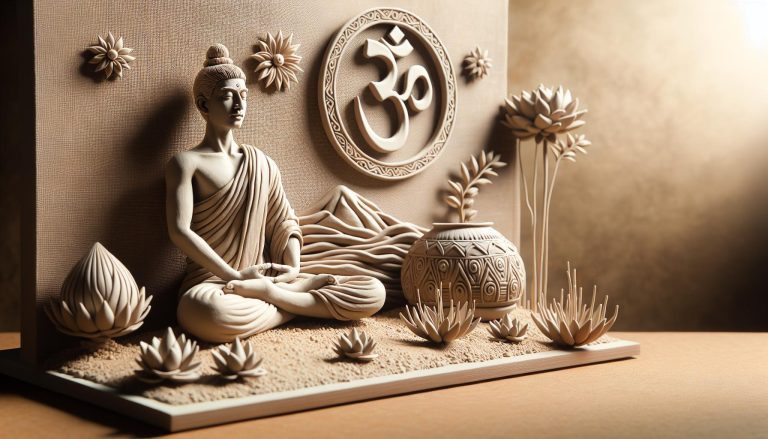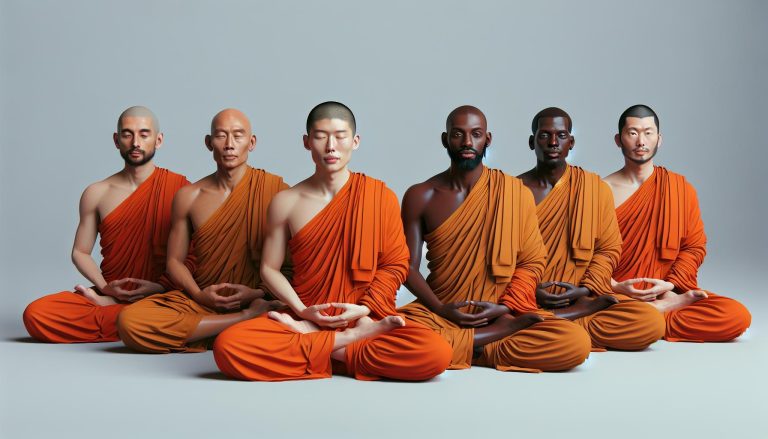Buddhist Mantra Secrets for Achieving Inner Peace
In the hustle of everyday life, finding tranquility can seem like a distant dream. But what if you could access a wellspring of inner peace anytime, anywhere? Buddhist mantras have been a beacon of calm for centuries, offering a simple yet profound tool to quiet the mind and soothe the soul.
By integrating these ancient chants into your daily routine, you’re not just reciting words; you’re tapping into a timeless practice that has helped countless individuals cultivate serenity and balance. Whether you’re a seasoned practitioner or new to the concept, exploring Buddhist mantras might just be the key to unlocking the peace you’ve been seeking.
What is a Buddhist Mantra?
When you’re seeking a path toward inner peace, you might stumble across the term “Buddhist mantra” and wonder exactly what it entails. A Buddhist mantra is essentially a sequence of words in Sanskrit, Tibetan, Pali, or another ancient language, believed to possess spiritual potency and transformative power. These mantras are more than just phrases; they’re tools that enable you to tap into a deeper consciousness and promote healing and serenity within yourself.
Amongst the myriad of mantras available, each serves a distinct purpose. Some are recited for protection, others for healing, while many aim to foster concentration and mindfulness. The mantras often center around the names of deities or core philosophical concepts, embodying the essence of the teachings they represent. By chanting these sacred texts, you immerse yourself in the vibration of these powerful teachings, aligning your energy with the harmonious intention they carry.
Starting with “Om Mani Padme Hum,” one of the most famous mantras, you can begin to grasp the vibrational impact such a chant has on your mind and body. When you recite this mantra, you’re invoking the benevolent attention of Chenrezig, the embodiment of compassion, and affirming your desire to attain enlightenment for the benefit of all living beings. This is just one example of how a mantra can directly influence your state of being.
Integrating mantras into your daily life doesn’t require hours of meditation or an extensive background in Buddhism. It’s about consistency and presence in the moment. You could start or end your day with a few minutes of mantra repetition or incorporate them into your meditation practice. The key is in the repetition, allowing the rhythm and flow of the chant to anchor your mind away from distractions and towards tranquility.
Buddhist mantras work through their rhythm, sound, tone, and, most importantly, the intention behind them. With regular practice, you’ll notice a shift in your thoughts and emotions, moving towards the balance and peace you’re searching for. And as you deepen your connection to these ancient chants, you’ll uncover layers of calm and clarity that were always present, just waiting to be accessed through the doorway of sacred sound.
The Importance of Inner Peace

Achieving inner peace is more than a momentary state of calm. It’s about finding a sense of stability and tranquility that resonates through all facets of your life. Living in today’s fast-paced world, the search for serenity can often feel like a journey with no compass. Yet, in the midst of life’s storms, it’s inner peace that offers you an anchor.
Integrating Buddhist mantras for inner peace is a practice rooted in tradition, yet undeniably applicable to the modern struggles you face daily. It’s a tool to help you foster resilience against stress and anxiety. When you chant these ancient words, you’re not just speaking syllables; you’re setting intentions and harnessing a force that has withstood the test of time to bring equanimity to the human spirit.
The rhythmic nature of mantras tends to calm the mind, much like the repetitive waves soothe the shore. Consistent practice of these mantras can lead to a gradual unwinding of the mind’s tendrils of tension, allowing you to confront life’s challenges with a grounded and clear-minded approach. It’s not about silencing your thoughts; it’s about reaching a state where those thoughts no longer have the power to disrupt your peace.
Beyond reducing stress, inner peace is vital for improved concentration, enhanced relationships, and overall well-being. It encourages you to react to situations with thoughtfulness rather than impulse, and fosters a more compassionate view towards both yourself and others. When you’re at peace, your presence can have a calming effect on those around you, creating a more harmonious environment for everyone.
The power of mantras lies in the belief that what you vocalize you can materialize. By incorporating mantras into your routine, you’re actively contributing to a more peaceful inner world. That peace, in turn, ripples outwards—it becomes a part of every action you take and every decision you make.
Remember, the pursuit of inner peace is a continuous journey. While you might not master tranquility overnight, each mantra you chant is a step towards a centering experience that nurtures your mind, body, and soul. As you weave these practices into the fabric of your daily life, you’ll likely notice subtle yet significant shifts in your perspective. These shifts are the building blocks of a tranquil existence, ensuring that peace becomes not just a fleeting feeling, but a foundational aspect of your being.
Exploring Buddhist Mantras

When you’re seeking a sense of calm and balance, Buddhist mantras stand out as a powerful tool to bring tranquility into your life. These mantras are more than just words or sounds; they’re vibrations that align with the frequency of peace and well-being.
Think about how a pebble creates ripples across the surface of a still pond. In a similar way, repeating mantras sends ripples through your mind, stilling erratic thoughts and allowing for a smoother mental flow. This simplicity is key to their effectiveness. By focusing your attention on a single, repetitive verse, you’re able to quiet the noise and distractions that often invade your thoughts.
Among the most revered mantras in Buddhist practice, the Om Mani Padme Hum is often chanted to invoke compassion and liberation from suffering. Each syllable in this mantra is believed to be transformative, opening you up to various positive qualities:
- Om – Purifies ego
- Ma – Purifies jealousy
- Ni – Purifies passion
- Pad – Purifies ignorance
- Me – Purifies greed
- Hum – Purifies hatred
By chanting these syllables, you’re not just reciting words; you’re engaging in an ancient practice that has helped countless individuals find solace and clarity in their lives.
Intertwining mantras into your daily routine doesn’t require hours of meditation. A few moments of mindful chanting, whether at the start of your day or during a break in your busy schedule, can make a significant difference. Even as you walk, work, or carry out chores, silently or aloud, repeating a mantra can keep you centered.
It’s all about making the practice your own. Find a mantra that resonates with you and use it as your anchor. Over time, as the mantra becomes a natural part of your rhythm, you’ll likely notice an increased sense of presence and focus in your everyday life.
Each mantra is a gateway to a more peaceful state of being. When you incorporate these sacred phrases into your day, you’re taking proactive steps towards nurturing your mind and spirit.
Different Types of Buddhist Mantras

When you start delving into Buddhist mantras, you’ll find there’s a rich tapestry of chants and phrases, each with its own unique frequency and purpose. Mantras serve various functions, from cultivating compassion to aiding in meditation or protecting the mind against negative influences.
In your journey toward inner calm, you might encounter the Green Tara Mantra, “Om Tare Tuttare Ture Soha”. It’s recited for protection and to overcome physical, mental, or emotional blockages. It’s believed to be especially powerful in times of upheaval or distress, acting as a spiritual balm for your well-being.
Another beacon of serenity is the Medicine Buddha Mantra, “Tayata Om Bekanze Bekanze Maha Bekanze Radza Samudgate Soha”. Turning to this chant is much like an appeal for healing energy, not just for physical ailments but also for the ills of the spirit.
You might also find solace in the Heart Sutra Mantra, “Gate Gate Paragate Parasamgate Bodhi Soha”. This mantra encapsulates the essence of the prajnaparamita teachings, which can help dismantle the constructs of traditional thought and lead you to a place of greater wisdom and liberation from suffering.
Here’s a quick reference for some widely used mantras:
- Om Mani Padme Hum: Purifies the heart and mind
- Om Muni Muni Maha Muniye Soha: Connects you to the wisdom of the Buddha
- Om Ah Hum Vajra Guru Padma Siddhi Hum: Invokes the blessings of the Guru Rinpoche
Remember to approach each mantra with reverence. Your intent and devotion are just as important as the words themselves. Integrate them into your daily practices, and you’ll likely notice a shift toward a more peaceful and centered existence. Remember, your exploration of mantras is a personal one; feel free to try different ones until you find the chant that resonates with you.
How to Choose the Right Mantra for You

Selecting the right mantra can be a personal journey, one that resonates with your individual aspirations and spiritual needs. When picking a mantra, it’s not just about the words; it’s about the connection you feel and the vibration that reverberates within your soul. Here’s a straightforward guide to help you find the mantra that speaks to your heart.
Reflect on Your Intentions
Before you begin, think about what you’re aiming to achieve. Do you need healing, or are you seeking peace? Your goals will guide you toward a mantra that aligns with your purpose. Mantras like Om Mani Padme Hum are crafted for general well-being, while others like the Green Tara Mantra are more focused on specific aspects like compassion or enlightenment.
Familiarize Yourself with Different Mantras
- Om Mani Padme Hum – Enhances compassion and purifies the heart.
- Medicine Buddha Mantra – For healing and release from suffering.
- Heart Sutra Mantra – Cultivates wisdom and a clear mind.
Experience the Sound and Feel
Mantras aren’t just about the meaning of the words but how they sound and feel when recited. Chant each one several times and notice the sensations and emotions they stir within you. You’ll find that certain mantras have a natural pull, almost like they’re calling out to you.
Start Small and Be Consistent
Once you’ve chosen a mantra, start incorporating it into your daily routine. Consistency is key. Begin with a short session in the morning or evening and slowly build up the duration. The regular vibrations of the mantra can attune your energy and foster a serene inner landscape, making way for inner peace.
By selecting a mantra that truly fits your spiritual path, you harness a powerful tool for your inner development. Your consistent practice can transform your mantra from a simple phrase into a profound catalyst for peace and self-discovery.
Incorporating Mantras into Your Daily Routine

Adopting mantras into your everyday life doesn’t have to be overwhelming. Start by choosing a specific time of day to recite your mantra; it could be right after you wake up, during your lunch break, or just before you go to bed. Consistency is key, so stick to the same time slot to establish a habit.
Make It a Habit
- Wake up to your mantra: Mutter it as you open your eyes to set a positive tone for the day.
- Lunchtime reflection: A quick pause amid the day can recharge your mind.
- Evening ritual: Wind down your day with a few minutes of mantra recitation to promote restful sleep.
Integrate Mantras with Activities
Combine your mantra practice with daily actions to anchor them in your life:
- Pair it with breaths during your morning stretch.
- Repeat it silently as you commute.
- Overlay your exercise routine with focused mantra repetition.
Incorporate mantras during moments of stress. If you’re feeling anxious or overwhelmed, taking a few minutes to focus on your mantra can bring a sense of calm and centering.
Gradual Build-Up
Don’t pressure yourself to sit for long sessions right away. Start with just a couple of minutes each day and gradually increase the duration as you become more comfortable. You’ll find that the mantra starts to surface in your thoughts more naturally the more you practice.
Remember to be patient with yourself; like any other practice, it takes time to feel the effects. Encourage yourself to stay dedicated and gently guide your thoughts back to your mantra whenever they wander.
The most profound transformations often come from the simplest changes. Tailoring the practice of mantras to fit seamlessly into your lifestyle not only ensures that you’ll stick with it but also maximizes the benefits you’ll reap from this ancient and powerful tradition.
Benefits of Practicing Buddhist Mantras

When you dive into the world of Buddhist mantras, you’ll discover that these sacred phrases do more than just fill the silence. They’re a key that unlocks a myriad of mental and emotional benefits. Practicing Buddhist mantras can significantly reduce stress levels, allowing your mind to enter a more peaceful state. Imagine the stress of your day melting away as you repeat these powerful words, instilling a sense of serenity.
Moreover, mantras can enhance focus and concentration. In a world brimming with distractions, finding that laser-like focus can be tough. But by integrating mantras into your daily life, you train your brain to block out the noise and zero in on the task at hand. This could improve your productivity at work and your ability to enjoy the present moment.
Let’s talk about emotional well-being. Regularly reciting mantras can foster emotional healing and resilience, nurturing your inner peace. You’ll find yourself better equipped to handle the ups and downs of life with grace and equanimity. Mantras serve as a reminder of your inner strength, helping to alleviate feelings of anxiety and depression.
And don’t underestimate the physical benefits that come along for the ride. As you calm your mind and soothe your emotions, you’re also likely to see improvements in your physical health. Lower blood pressure, improved sleep patterns, and a fortified immune system are just a few of the physical upsides to a steady mantra practice.
Here’s a tip: to truly reap these benefits, consistency is key. Make your mantra recitation a non-negotiable part of your day, just like brushing your teeth or having your morning coffee. Over time, you’ll notice the profound effects that these ancient words can have on all aspects of your well-being.
Tips for Chanting Mantras Effectively

When you’re seeking inner peace through Buddhist mantras, knowing how to chant them effectively can make all the difference. Here’s what you need to keep in mind to get the most out of your practice.
Find a Comfortable Space
Chanting mantras requires a degree of tranquility and seclusion. Seek out a spot where you won’t be interrupted – this could be a dedicated corner of your home or a quiet spot in nature. Make sure you feel at ease in this space, as comfort is key to maintaining focus.
Adopt the Right Posture
Your physical posture can influence your mental state. Sit with your back straight, yet relaxed, and your hands resting gently on your lap or knees. This position facilitates a smooth flow of energy as you chant.
Choose Your Mantra Wisely
Pick a mantra that resonates with you. Different mantras serve diverse purposes – some for peace, others for strength or wisdom. Do your research or consult with an experienced practitioner to find one that aligns with your intention.
Pronunciation and Rhythm Matter
Articulate your chosen mantra clearly and maintain a steady rhythm. The sound vibration is as important as the words themselves – it’s the repetitive sound pattern that aids in achieving a meditative state.
Regular Practice Is Key
Like any skill, proficiency in mantra chanting grows with regular practice. Set aside time each day for this practice. Consistency not only hones your ability to chant but also deepens the mantra’s impact on your life.
By integrating these tips into your mantra chanting routine, you’ll enhance not only the quality of your practice but also the peace and serenity you derive from it.
Remember, the path to inner peace is personal and unique to each individual. Trust your instincts, and allow your mantra practice to evolve naturally as you gain experience and insight.
Transforming Your Inner World through Mantras

When you start incorporating mantras into your daily routine, you’re tapping into ancient wisdom that can radically shift your internal landscape. The vibrations and sounds of these sacred phrases are designed to quiet the chatter in your mind, paving the way for tranquility and clarity.
Mantras work like a tuning fork for your emotions, aligning you with frequencies of peace and stability. Each recitation allows you to peel away layers of stress and unease, bringing your mental state closer to a Zen-like calmness. What you’re really doing is setting the stage for a profound transformation within, one that can lead to lasting serenity.
To really see a difference, it’s about making mantras a part of who you are. Repetition is key. As you repeat these powerful phrases over and over, you’ll find yourself drifting into deeper states of meditation. This can have a ripple effect throughout your life, influencing the way you handle challenges and interact with others.
Choosing the right mantra is crucial as well. You’ll want to select one that speaks to your heart, whether it’s the simple yet profound “Om” or something more elaborate. The meaning behind the words can serve as a constant reminder of the peace and positivity you are striving to cultivate.
Mindful breathing is another important aspect to consider. It should synchronize with your chanting, creating a seamless flow of breath and voice. This combination is what makes the practice so powerful – it’s not just an auditory experience but a full-bodied one.
Remember, the goal isn’t just to say the words; it’s to feel them reverberate through every part of your being. With every chant, imagine sending waves of harmony and balance throughout your body, touching every corner of your soul.
And don’t get caught up in perfectionism. Your mantra practice isn’t about hitting the right notes; it’s about the journey towards inner stillness. Allow yourself to move with the mantra, letting it evolve and grow with you as you continue on your path to inner peace.
Conclusion
Embrace the power of Buddhist mantras to unlock a deeper sense of peace within yourself. By integrating these sacred phrases into your daily life you’re taking a significant step towards harmony and tranquility. Remember that consistency is key and your dedication to the practice will yield transformative results. Let the vibrational energy of each word guide you to a place of stillness and clarity. Trust in the journey and watch as inner peace blossoms in your heart with every chant.







